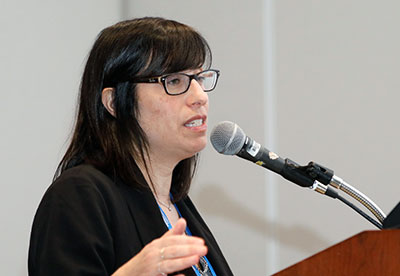Expert Outlines Practical Tactics Parents, Practitioners Can Use to Help Teens Overcome Suicidal Urges

There are many common elements among evidence-based treatments for reducing suicidality in adolescents that psychiatrists can easily put into practice to help troubled teens survive these turbulent years.
The prevalence of suicidality increases dramatically as children approach the adolescent years: Close to 1 in 5 adolescents reports seriously considering suicide, and close to 1 in 10 has attempted suicide in the past year, explained Michele S. Berk, Ph.D., at an Annual Meeting session on treatment approaches for suicidal adolescents.
Suicide rates among 10- to 19-year-olds increased 56% between 2007 and 2016. In fact, suicide is the second-leading cause of death in the United States among individuals 10- to 34-years-old.
“We still have a long way to go in terms of suicide prevention among adolescents,” said Berk, an assistant professor in the Department of Psychiatry at Stanford University. “It’s critical that mental health professionals who work with adolescents or families familiarize themselves with evidence-based approaches to treating suicidal behavior.”
Part of the challenge for researchers is a lack of consistency around the globe on how self-harm and suicide attempts are defined. For example, studies in Europe focus on “self-harm,” which loops in all self-injurious behavior, regardless of the patient’s intent, whereas U.S. researchers differentiate between suicide attempts and self-injurious behavior without suicidal intent. As a result, it is not easy to compare or analyze data between the two regions.
Also, some parents and emergency department staff tend to dismiss non-suicidal self-injury among youth as merely attention seeking or not serious. Yet several studies have shown it to be a significant predictor of future suicide attempts. This behavior “may break down natural barriers humans have against harming oneself that make it easier to later inflict fatal self-harm,” Berk said.
There are six treatments for which randomized clinical trials have shown significant benefit in reducing suicide in this population: dialectical behavior therapy for adolescents (DBT-A), mentalization therapy for adolescents (MBT-A), cognitive-behavioral therapy for co-occurring suicidal behavior and substance use (I-CBT), multisystemic therapy (MST), attachment-based family therapy (ABFT), and the safe alternatives for teens and youth (SAFETY) program.
“However, these are not always easy to translate into practice for private practitioners or even community health centers,” Berk said. Many of the treatments are labor intensive, require multiple simultaneous types of therapy (group, family, and individual), necessitate a large treatment team trained in specific methods, and involve a lengthy time frame for patient treatment.
Across these treatments, psychiatrists can easily incorporate many important elements into practice to reduce adolescent suicide risk:
- Schedule family-based treatment to reduce family conflict.
- Focus initial treatment on reducing risk of suicidal self-harm until risk is low, rather than on treating the patient for diagnosis such as depression.
- Remove lethal means from the home, including guns, sharp objects such as kitchen knives, prescription and over-the-counter medications (particularly acetaminophen), alcohol, and household poisons or cleaning products like bleach.
Berk spends a lot of time educating parents on removal of these items because many balk and say that patients could simply use another means of suicide. To counter this argument, Berk uses dieting as an example: “If you were on a diet and there was a big chocolate cake sitting on the counter, versus if you had to drive to the store to get the cake, which scenario would lead to more success?”
- Regularly search the rooms of suicidal teenagers to look for lethal means and accompany them when they leave the house.
- Help youth create a safety plan. Completing a youth safety plan (templates are available free online) allows teens to detail warning signs of and coping mechanisms for a suicidal crisis. Berk said these are very low–effort, high-yield interventions. She advised clinicians to give a copy to the youth so that he or she can refer to it when a crisis arises.
- Assemble a hope box. Adolescents assemble a “hope box” filled with personal items that can help them cope in a moment of suicidal crisis. It might include art supplies; modeling clay; a journal; crossword puzzles; a small plush toy; a stress ball; and reminders of their reasons to live such as notes from friends, photos of a beloved pet and family members, or awards.
- Create a formal agreement to continue treatment. Studies have shown that as many as 70% of adolescents seen for suicide risk in the emergency department do not seek mental health treatment once they leave.
(Image: David Hathcox)
|
|
|
|
|

